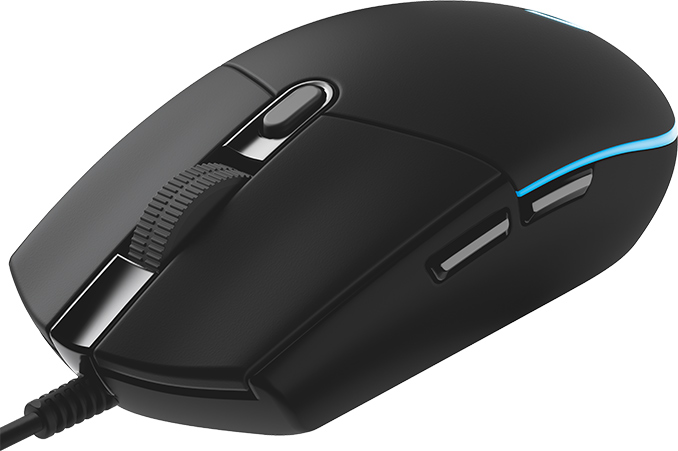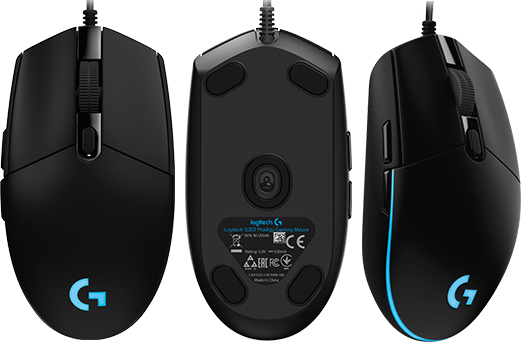Logitech Launches G203 Prodigy Gaming Mouse with A New 6000 DPI Sensor
by Anton Shilov on January 19, 2017 11:00 AM EST- Posted in
- Peripherals
- Gaming
- Logitech
- Mice
- Logitech G
- G203 Prodigy

Logitech this month introduced its new G203 Prodigy gaming mouse that combines a classic aesthetic with a high-resolution sensor, programmable buttons and RGB LED lighting. What is important is that the mouse is considerably less expensive than typical gaming mice.
Computer mice have greatly evolved in the past decade as manufacturers try to offer better ergonomics for different types of users and applications. Many mice today feature additional buttons and/or a rather fancy shape because their producers try to address hardcore gamers or prosumers looking for maximum comfort during their many-hour game or work sessions, with many users preferring different grips and layouts. The Logitech G203 Prodigy is promoted as a departure from the concept of complex design and we are told it brings ergonomics back to basics - the new mouse is made to resemble a simplistic shape that popular mice are known for, but we are told it can be done without sacrificing usability.
The Logitech G203 Prodigy is based on one of the company’s in-house-customized sensors with on-the-fly adjustable resolution (200-6000 DPI) along with an ARM processing core that supports USB report rate of 1000 Hz (appropriate software is required for relevant operating systems). Just as in the case of the higher end devices, the G203 Prodigy can be completely reprogrammed using Logitech’s software and then used on different PCs since button configuration is stored inside the mouse. Finally, developers of the G203 could not ignore the trend and installed a programmable RGB LED into the G logotype on the mouse.
One of the important aspects of the Logitech G203 Prodigy is its price: the company sells it for $39.99 in the U.S. and for €44.99 in the E.U., which is below the price of typical gaming mice that may retail for well over $100. Knowing that Logitech develops various product designs, high-resolution sensors and other components in-house, it is likely that the creation of the G203 Prodigy is a response to the demand of potential customers rather than an attempt to address a lower-end market segment currently controlled by various bulk production companies with a cheap product. The G203 Prodigy is made in Switzerland and thus passes all the rigorous tests that Logitech uses to promote the quality of its products.
As pointed out on Twitter by @AfterPad, this is an update to the previous generation Logitech G102.
Meanwhile, an interesting thing to consider is that the price of the Logitech G203 Prodigy will be very attractive not only to gamers who do not need fancy design, adjustable weight or plenty of additional buttons, but also makers of higher-end PCs designed for gamers. The G203 Prodigy is the most affordable gaming mouse from the company and thus becomes a good candidate to be supplied with pre-built systems.
Related Reading:
- Logitech 2014 Switzerland Tech Day: The Hills Are Alive With The Sound Of Romer G
- Logitech Announces The Ambidextrous G900 Chaos Spectrum Gaming Mouse
- Logitech Formally Exits OEM Mouse Market
- The Logitech G910 Orion Spectrum Mechanical Keyboard Review
- Logitech Acquires Saitek Brand and Product Lines, Expands Its Sim Controllers Biz
Source: Logitech

















52 Comments
View All Comments
Lolimaster - Thursday, January 19, 2017 - link
You will always get additional latency + another point of failure being "wireless".limitedaccess - Thursday, January 19, 2017 - link
There are performance gaming oriented mice now with basically no latency penalty. If we look at the G403 wired vs wired (basically the exact same mouse otherwise) at least from what testing I've seen if there is a latency penalty is would be under 1ms.Something to note is that not all wired mice (even gaming wired mice) have the same optimizations for click latency (affected by other factors), so mice like the G900 and G403 wireless will actually have lower click latency than many other wired gaming mice.
BrokenCrayons - Thursday, January 19, 2017 - link
I just started doing a little digging and it looks like a couple of things are the case...Logitech does make a premium wireless mouse and that wireless mouse was demonstrated as having about half the latency of a competing Razer wired gaming mouse. That's probably not the case for a budget wireless mousey that doesn't have a lot of engineering work behind it, but I'm not convinced sending a signal through the air is inherently an indicator of worse performance.http://www.gamersnexus.net/guides/2594-wireless-mo...
BurntMyBacon - Friday, January 20, 2017 - link
The same mouse in the same test in wired mode has even less latency than with wireless.Granted, it was a Logitech test setup, but they were not expecting to run the test in wired mode for comparison against the wireless mode:
http://www.tomshardware.com/news/logitech-g900-cha...
That all said, we've clearly hit diminishing returns on the latency front. So while you can still say with certainty that electron to wireless signal conversion, noise filtering, and wireless signal to electron conversion will always necessitate some additional latency, the amount of additional latency is no longer guaranteed to be discernible.
bigboxes - Friday, January 20, 2017 - link
I've got a 15 year old wireless mouse still going strong. Where's this "another point of failure"?limitedaccess - Thursday, January 19, 2017 - link
There are gaming performance oriented wireless mice like the G900 and G403 wireless but they have much lower battery life (both listed at 32 hours). In those cases there is basically no latency penalty. I guess if we compared the G403 vs G403 wired the only real trade off is a higher weight which is arguably offset by the lack of cable.The types you are likely referring to, with the long battery life, are trading off performance characteristics for battery life (wireless latency, sensor, weight, etc.).
rxzlmn - Thursday, January 19, 2017 - link
I have a Logitech G602, there's a switch on it which allows to toggle between either high-polling/performance mode and a regular 'eco' mode in which the battery lasts very long. To be honest I can't feel any difference in latency between this and the wired G303 (when playing FPS).Madpacket - Friday, January 20, 2017 - link
I think weight is the biggest hurdle with wireless mice now that latency is no longer an issue.Wall Street - Friday, January 20, 2017 - link
The main advantage of wired isn't latency, it is weight. Smaller mice like the G Pro, G100s, Zowie FK2 and Razer Abyssus are best at 80-90 grams weight. This is hard to achieve in a mouse that needs a battery. Most wireless mice weight at least 110 grams, which is too much for fingertip grip and low sensitivity.lmcd - Thursday, January 19, 2017 - link
I find the comment on pricing surprising, as I've had a Steelseries Rival mouse that at $50 has a fairly normal grip, normal button count, and a solid sensor (though possibly not as good as this one, I wouldn't know). This barely prices better.While I'm sure this is a good mouse, I'm sure Razer and others also have equivalently-priced competitors. This is a response, not a breakthrough.